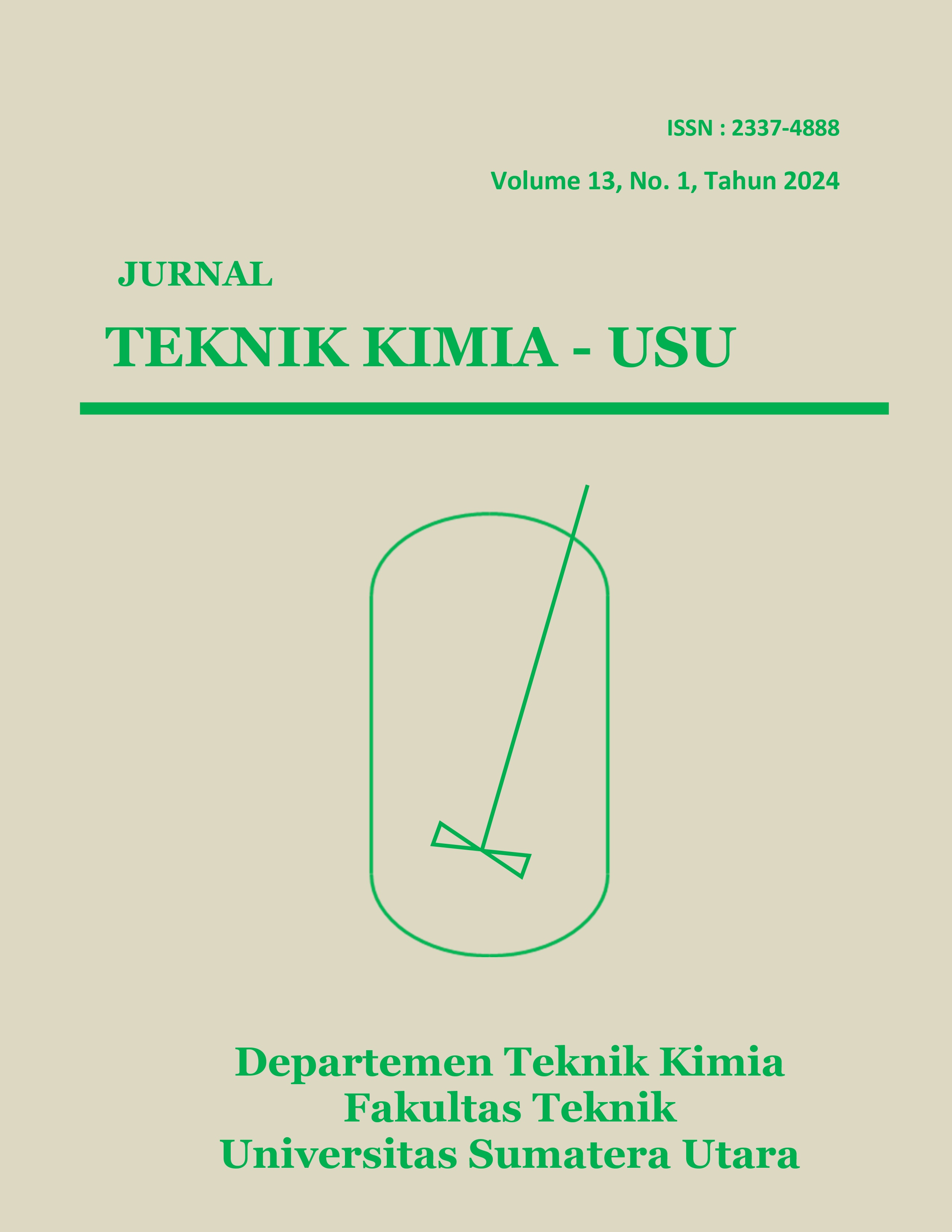Pengaruh Perlakuan Awal terhadap Karakteristik Bioetanol dari Limbah Kulit Singkong Karet (Manihot glaziovii)
DOI:
https://doi.org/10.32734/jtk.v13i1.13174Keywords:
bioethanol, rubber cassava peel, pretreatment, hydrolysis, fermentationAbstract
Rubber cassava peel waste (Manihot glaziovii) has a high carbohydrate content, so it is feasible to convert it into bioethanol. In general, bioethanol production consists of four steps, pretreatment, hydrolysis, fermentation, and purification. The purpose of this study was to determine the suitable treatment for obtaining bioethanol with the finest characteristics from rubber cassava peel using three treatment variations, the pretreatment process with variations in the dissolving ratio of sodium hydroxide (NaOH) 0.5 M of 1:10; 1:12.5; and 1:15 (w/v), the hydrolysis process with various concentrations of sulfuric acid (H2SO4) of 0.15 N; 0.30 N; and 0.45 N, and the fermentation process with variations in the fermentation time for 3 days, 7 days, and 9 days. Based on the research results, the highest glucose content was 0.91%, with variations in dissolving NaOH 0.5 M 1:15 (w/v) in the pretreatment process and variations in the concentration of 0.30 N H2SO4 in the hydrolysis process, while the highest ethanol content was 68.05% at a fermentation time of 7 days.
Downloads
References
A. F. Sa’adah, A. Fauzi, and B. Juanda, “Peramalan penyediaan dan konsumsi bahan bakar minyak Indonesia dengan model sistem dinamik,†J. Ekon. dan Pembang. Indones., vol. 17, no. 2, pp. 118–137, 2017.
Erna, I. Said, and P. H. Abram, “Bioetanol dari limbah kulit singkong (Manihot esculenta Crantz) melalui proses fermentasi,†J. Akad. Kim., vol. 5, no. 3, pp. 121–126, 2016.
K. O. Adiotomre, “Production of bioethanol as an alternative source of fuel using cassava and yam peels as raw materials,†Int. J. Innov. Sci. Eng. Technol. Res., vol. 3, no. 2, pp. 28–44, 2015.
A. Adekunle, V. Orsat, and V. Raghavan, “Lignocellulosic bioethanol: A review and design conceptualization study of production from cassava peels,†Renew. Sustain. Energy Rev., vol. 64, pp. 518–530, 2016.
A. P. Moshi, S. G. Temu, I. A. Nges, G. Malmo, K. M. M. Hosea, E. Elisante, and B. Mattiasson, “Combined production of bioethanol and biogas from peels of wild cassava Manihot glaziovii,†Chem. Eng. J., vol. 279, pp. 297–306, 2015.
P. Widyastuti, “Pengolahan limbah kulit singkong sebagai bahan bioetanol melalui proses fermentasi,†J. Kompetensi Tek., vol. 11, no. 1, pp. 41–46, 2019.
M. A. Hapsari and A. Pramashinta, “Pembuatan bioetanol dari singkong karet (Manihot glaziovii) untuk bahan bakar kompor rumah tangga sebagai upaya mempercepat konversi minyak tanah ke bahan bakar nabati,†J. Teknol. Kim. Dan Ind., vol. 2, no. 2, pp. 240–245, 2013.
N. Z. Firdausi, N. B. Samodra, and Hargono, “Pemanfaatan pati singkong karet (Manihot glaziovii) untuk produksi bioetanol fuel grade melalui proses distilasi-dehidrasi menggunakan zeolit alam,†J. Teknol. Kim. dan Ind., vol. 2, no. 3, pp. 76–81, 2013.
E. Nuwamanya, L. Chiwona-Karltun, R. S. Kawuki, and Y. Baguma, “Bio-ethanol production from non-food parts of cassava (Manihot esculenta Crantz),†Ambio, vol. 41, no. 3, pp. 262–270, 2012.
S. S. Jati and T. Widayatno, “Pengaruh konsentrasi kapang dan lama waktu fermentasi terhadap kadar bioetanol dari limbah kulit singkong (Manihot esculenta),†J. Tek. Kim. USU, vol. 11, no. 2, pp. 102–109, 2022.
E. Praputri, E. Sundari, F. Firdaus, and S. Sofyan, “Penggunaan katalis homogen dan heterogen pada proses hidrolisis pati umbi singkong karet menjadi glukosa,†J. Litbang Ind., vol. 8, no. 2, p. 105, 2018.
Badan Standardisasi Nasional, “SNI 01-2891-1992: Cara uji makanan dan minuman,†Standar Nasional Indonesia. 1992.
D. Pinata and R. Nawfa, “Uji kualitatif etanol yang diproduksi secara enzimatis menggunakan Z. Mobilis permeabel,†in Prosiding Kimia FMIPA, Institut Teknologi Sepuluh Nopember, 2010, pp. 1–6.
A. I. Perdana, “Optimasi dan validasi metode analisis kadar alkohol pada produk pangan dengan spektrofotometer UV-Vis,†J. Inov. dan Pengelolaan Lab., vol. 2, no. 1, pp. 28–38, 2020.
C. A. Cardona, O. J. Sanchez, and L. F. Gutierrez, Process synthesis for fuel ethanol production, 1st ed. Boca Raton: CRC Press, 2009.
D. M. Maharani and K. Rosyidin, “Efek pretreatment microwave -NaOH pada tepung gedebog pisang kepok terhadap yield selulosa,†Agritech, vol. 38, no. 2, pp. 133–139, 2018.
H. R. Permatasari, F. Gulo, and B. Lesmini, “Pengaruh konsentrasi H2SO4 dan NaOH terhadap delignifikasi serbuk bambu (Gigantochloa apus),†J. Penelit. Pendidik. Kim. Kaji. Has. Penelit. Pendidik. Kim., vol. 1, no. 2, pp. 131–140, 2014.
Elwin, M. Lutfi, and Y. Hendrawan, “Analisis pengaruh waktu pretreatment dan konsentrasi NaOH terhadap kandungan selulosa, lignin dan hemiselulosa eceng gondok pada proses pretreatment pembuatan bioetanol,†J. Keteknikan Pertan. Trop. dan Biosist., vol. 2, no. 2, pp. 110–116, 2014.
S. Y. Tristianti, P. R. Sarjono, and N. S. Mulyani, “Aktivitas fusarium oxysporum dalam menghidrolisis eceng gondok (Eichhornia crassipes) dengan variasi waktu fermentasi,†Chem Info, vol. 1, no. 1, pp. 265–274, 2013.
T. Yoshikawa, S. Shinohara, T. Yagi, N. Ryumon, Y. Nakasaka, T. Tago, and T. Masuda, “Production of phenols from lignin-derived slurry liquid using iron oxide catalyst,†Appl. Catal. B Environ., vol. 146, pp. 289–297, 2014.
D. A. Permata, A. Kasim, A. Asben, and Yusniwati, “Delignification of lignocellulosic biomass,†World J. Adv. Res. Rev., vol. 12, no. 2, pp. 462–469, 2021.
Q. Xiang, Y. Y. Lee, P. O. Pettersson, and R. W. Torget, “Heterogeneous aspects of acid hydrolysis of a-cellulose,†Appl. Biochem. Biotechnol., vol. 705, pp. 505–514, 2003.
Downloads
Published
Issue
Section
License
Copyright (c) 2024 Jurnal Teknik Kimia USU

This work is licensed under a Creative Commons Attribution-ShareAlike 4.0 International License.

















